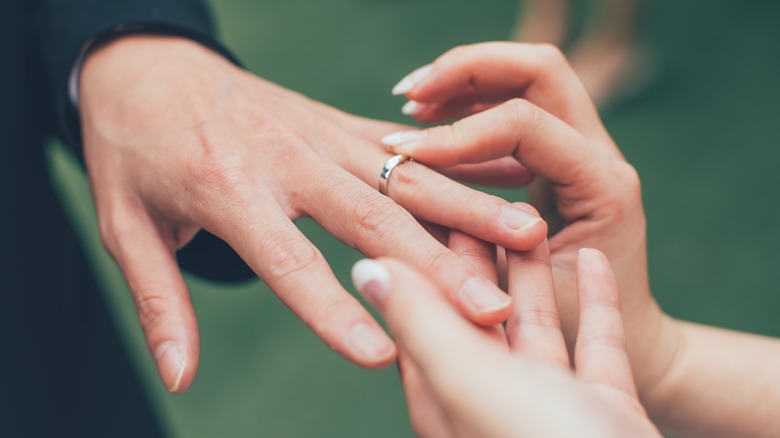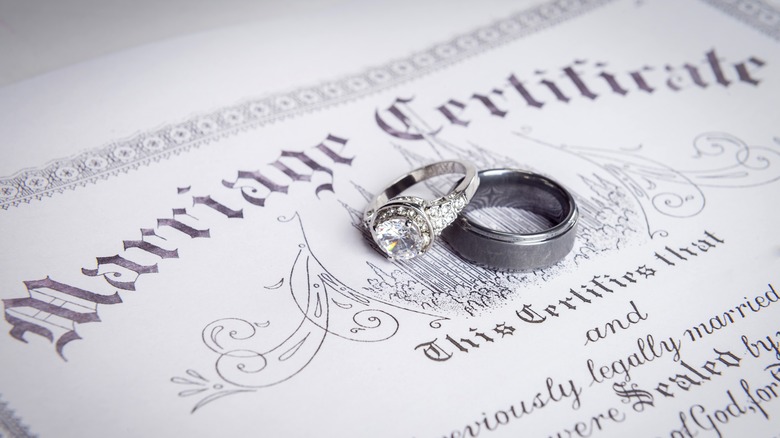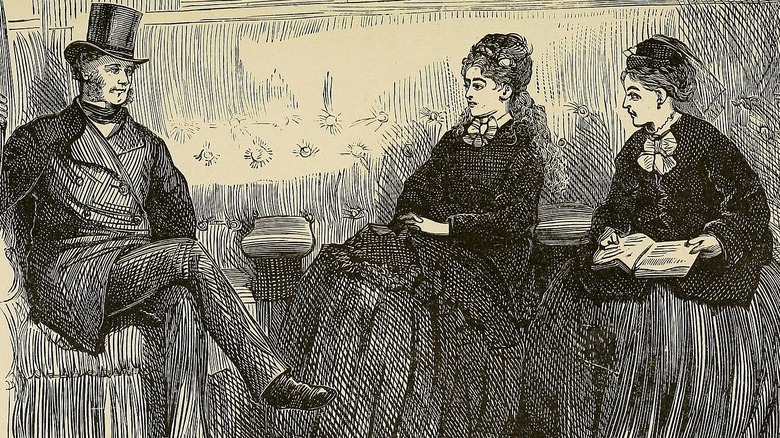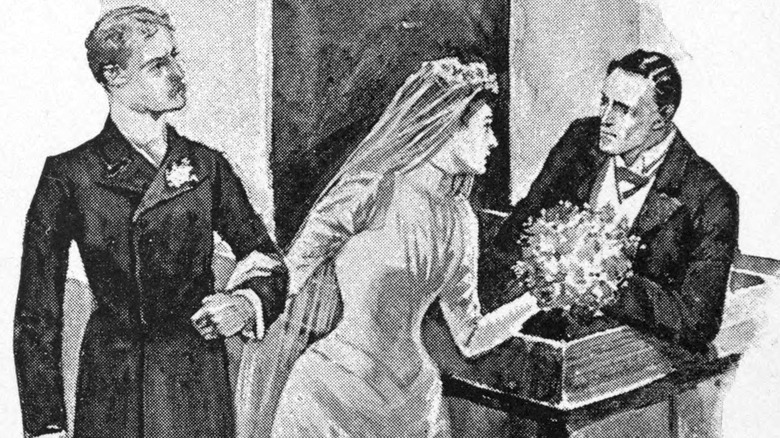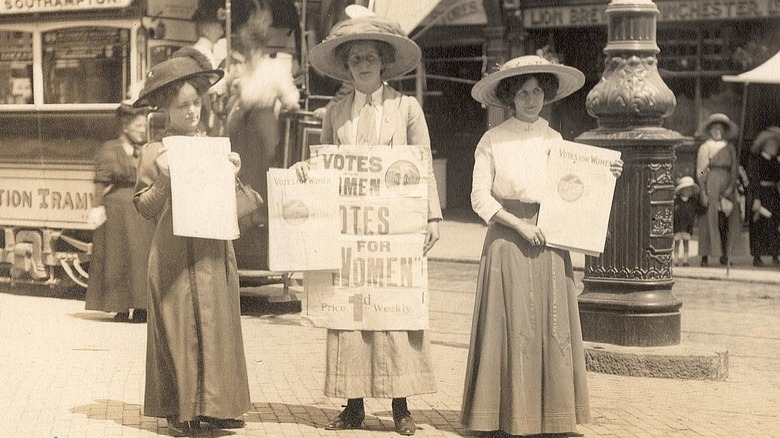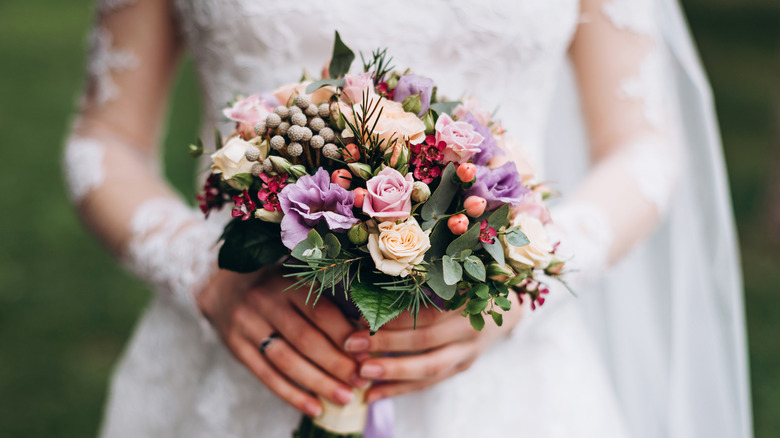The Surprising Origin Of Wedding Objections
The notion of wedding objections sometimes feels more like fodder for rom-com plotlines than an actual phenomenon, but the practice actually has a long and important history. That said, its original purpose wasn't exactly to give disapproving or lovelorn wedding attendees a last chance to make a dramatic gesture. Instead, its basis was a lot more practical.
One of the biggest reasons for wedding objections was to ensure that the couple getting married could legally be married. For starters, though forms of identification like social security numbers, passports, or drivers' licenses may seem like obvious necessities for modern life, the concept of a governmental ID is actually pretty new. According to Harvard's FXB Center for Health and Human Rights, Napoleon Bonaparte was the first to establish a sort of precursor to the modern ID. As part of his push to refine laws about property rights and build a federal system, he created an apparatus of ID documents for government workers starting in 1803.
Though these documents were for internal use only, the idea spread across the globe. For example, Sultan Mahmud II, ruler of the vast Ottoman Empire, was inspired enough to take it a step further and introduce national ID cards in 1844. However, it wasn't until the outbreak of World War II that the practice of national IDs really took hold internationally.
Before the invention of the ID, it was easy to be anyone
In a time before IDs were put into place, it was easy to discard and create new identities, and with new identities came lots of opportunities for fraud. As a result, people who legally should not have been allowed to get married were nevertheless making their vows. After all, all a couple had to do was travel to a distant town and a wedding officiant would probably not know whether the couple was brother and sister or if the bride was underage — two things that obviously would make a marriage illegal.
To combat the cases of fraud, the 1549 marriage liturgy section of the "Book of Common Prayer" issued a new addition to the marriage ceremony for Anglican marriages: the phrase "should anyone present know of any reason that this couple should not be joined in holy matrimony, speak now or forever hold your peace" (via Brides). Other branches of Christianity, such as Catholicism and Eastern Orthodox Christianity, soon added their own similar phrases to follow suit.
This created a system of self-policing and allowed everyone from everyday people to lawyers to stop a wedding mid-ceremony and ensure that the authorities had performed due diligence if there were any doubts about the legality of the match.
Bigamy was sort of a big problem in England
One of the problems facing Regency and Victorian England was bigamy. Since divorce was difficult and expensive, many men and women decided to run away and start a new life — and a new marriage. According to Reviews in History, the "Judicial Statistics of England and Wales" recorded 5,327 bigamy trials between 1857 and 1904. However, historian Ginger Frost has estimated that the true number was probably five times higher.
This hypothesis is supported by the fact that judges were incredibly lenient on sentences for bigamists; by the 1890s, around 37% of those found guilty spent less than a month in jail. Moreover, the specter of bigamy loomed so large that it made its way into popular Victorian literature, such as "Lady Audley's Secret," "David Copperfield," and "Middlemarch." However, the most famous bigamy-centered story is generally regarded to be "Jane Eyre." In an iconic scene, Jane and her love interest, Mr. Rochester, are about to exchange their vows on the altar when a wedding objector stands up. "The marriage cannot go on: I declare the existence of an impediment," he shouts, in what is now one of the most famous lines in literature (via Victorian Web).
Kidnapping, relatives, and heresy (oh my!)
Though bigamy was one of the biggest rationales behind adding the practice of wedding objections, there were other reasons as well. According to Vice, kidnapping a woman and forcing her into matrimony was shockingly common in Medieval England — and might just be the reason grooms traditionally stand to the right of the bride: that way, the groom's right arm — his sword arm — was ready to meet objections. But there are even more causes of illegal unions. Perhaps someone in attendance knew that one or the other of the marrying couple was still married to someone else. Or was underage. Or being coerced. Or (for a church wedding) was unbaptized. In those cases, it was considered a duty to object. "The same was true if they knew the couple to be too closely related by blood," noted an article in Brides.
Even with the ability to object to marriages, the issues still proved to be a major problem. England passed the 1754 Marriage Act to prevent the all-too-common aspects of "seduction, bigamy, and fraud" that were rife in wedding ceremonies. These new rules made it more difficult to get married, such as requiring both parties to have parental consent if under the age of 21.
But even that law had loopholes. The bill did not pass in Scotland, so young lovers often eloped to the border town of Gretna Green. There, they only needed to be 16 years old and "declare" their intentions to be husband and wife in front of two witnesses for the union to be legal (per Gretna Green).
Objections were especially vital during a time when women had fewer rights
Though at the surface wedding objections seek to avoid legal or ecclesiastical issues, the purpose actually runs much deeper. Throughout most of history, women did not have many rights, especially when it came to property rights. Generally, when a woman got married, her property was transferred to her husband.
Though these practices were common throughout the world, there was a specific term for this doctrine in the United States and the United Kingdom: coverture. According to The Library of Congress, the rules of coverture meant that a woman transferred all of her property to her husband upon marriage. Once there were laws enacted regarding the transfer of property and wealth upon marrying, allowing objections became more common (per Brides). Therefore, the use of wedding objections was important to help stop the transfer of property to a man who could later be outed as a bigamist or some other kind of fraud.
Wedding objections in today's world
Today, the tradition of asking for wedding objections is largely a relic of the past. In almost all countries across the globe, couples require a license that verifies there is no illegality in the union long before any marital vows. Many officiants have started to do away with the phrase altogether to avoid any awkward interruptions, according to Brides. However, for those ceremonies that still include the "speak now or forever hold your peace," note that they actually can't halt a wedding anymore.
"You can't object simply because you're in love with the bride. It has to be a legal reason why the couple can't wed," explained Paula Posman, a wedding officiant who also runs a wedding services company in New York. And if someone still objected to a wedding in modern times? "I would pause for a second and say, 'That's not a legal reason,' and continue with the ceremony," answered Posman (per Live Science).
